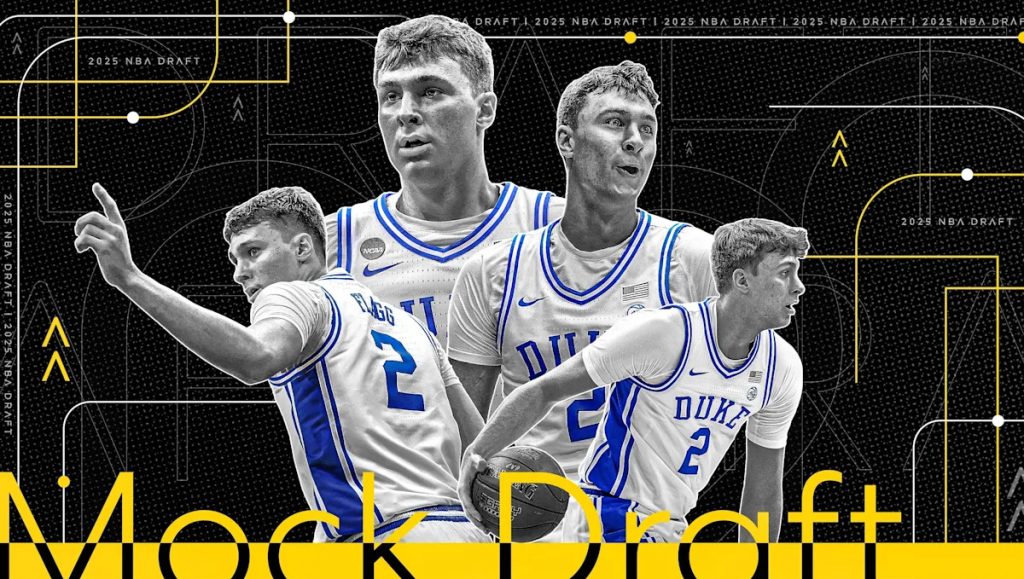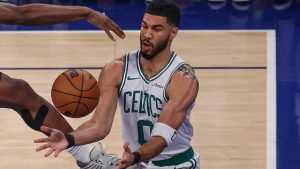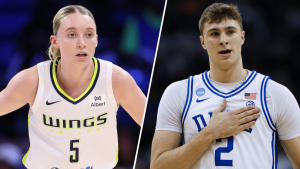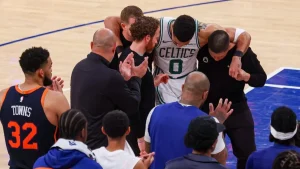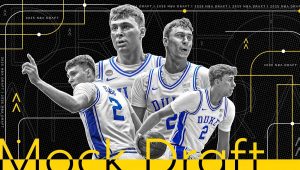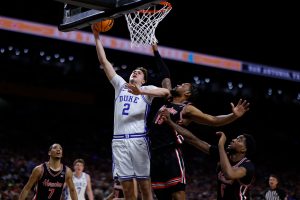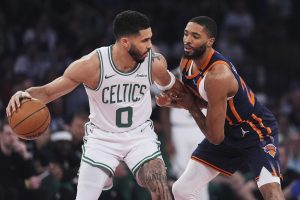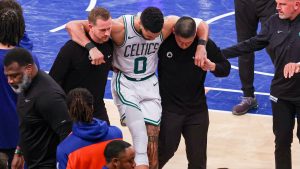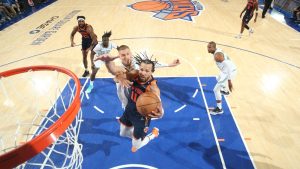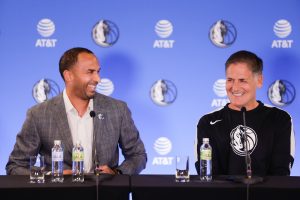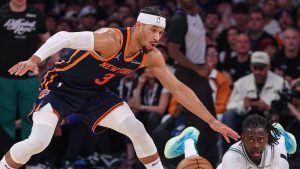With the Mavericks winning the NBA Draft Lottery — and the right to select Cooper Flagg with the No. 1 pick — let’s take our first stab at projecting how the draft will play out now that the order is set.
Below is my two-round mock. You can find this mock, plus scouting reports for every single prospect in the 2025 NBA Draft Guide.
1. Dallas Mavericks: Cooper Flagg, F, Duke
I genuinely can’t believe it actually happened. This result will not help the “NBA is rigged” accusations (and/or it works in favor of simulation theory) just months after the Mavericks traded Luka Dončić. But a big congratulations to the Mavericks and their remaining fans. So, now what will Nico Harrison do? He says defense wins championships, so Cooper Flagg makes some sense. But could the first pick have appeal to the Bucks for Giannis Antetokounmpo? The Mavericks will at least make that call. If they keep the pick, then Flagg fits as a do-it-all forward who hustles like a madman, makes his teammates better as a passer, and has dialed in a knockdown jumper. He’s both the best offensive and defensive prospect in this draft class, making him the safest No. 1 pick in ages. As long as his jumper falls, he could play as a small forward next to Anthony Davis and another big. It’s his growth as a shot creator that will decide if he reaches his All-Star floor or soars to his Hall of Fame ceiling.
2. San Antonio Spurs: Dylan Harper, G, Rutgers
With Antetokounmpo searching for his next franchise, the question now will be whether the Spurs trade this pick to land the Greek Freak or not. Harper is a big-bodied lefty combo guard with NBA blood in his veins, as the son of Ron Harper, who was a 20/5/5 guy before winning five titles as a role player. Like his father, Harper has a high-floor with the skill, poise and playmaking instincts to dictate the game at his pace. He obviously has talent, but the Spurs just traded for De’Aaron Fox and already have Stephon Castle. There’s too much overlap with Harper, meaning the Spurs could look to trade down or out.
3. Philadelphia 76ers: Ace Bailey, F, Rutgers
After a disastrous season, the Sixers get to keep their top-six protected pick. But drafting Bailey would raise serious questions about the direction of the franchise. On one hand, he is a ridiculous shot-making machine, capable of splashing contested jumpers from every spot on the floor and with the swagger of a throwback bucket-getter. At his size, he fits next to Tyrese Maxey and Jared McCain in the years to come. But can the Sixers afford to wait when the clock is ticking on the Joel Embiid era? Bailey’s shooting consistency, plus his raw edges as a shot creator and defender, need sanding down to turn him into a full-on star. It would not be a shocker if the Sixers look to trade down (or out) with a team badly hoping to land Bailey.
4. Charlotte Hornets: VJ Edgecombe, G, Baylor
Edgecombe is an explosive, high-motor wing who flies out of nowhere for poster dunks and chase-down blocks. He pairs his elite athleticism with a knockdown spot-up jumper and fearless slashing. Edgecombe needs to improve his shot creation to become more of a primary creator, but that’ll matter less in Charlotte as long as LaMelo Ball stays healthy.
5. Utah Jazz: Kon Knueppel, G/F, Duke
Knueppel brings more than just a sharpshooter’s stroke to the the Jazz thanks to his brainy pick-and-roll playmaking and crafty scoring feel. Pairing him with Lauri Markkanen works because Knueppel can simply fit with anyone. There could be some untapped upside in him too, since he’s got a slick midrange bag and strength scoring inside. To become a player that takes over games though, he’ll need to overcome his average athleticism.
6. Washington Wizards: Tre Johnson, G, Texas
As crushing as it is for the Wizards to get leapfrogged in the draft, maybe it could end up a blessing in disguise. The Wizards were last in offensive rating this season, so they are badly in need of a scoring punch from someone like Johnson. At Texas, Johnson showed he’s a clutch shot-maker who can catch fire from all over the floor, drilling step-backs and off-screen jumpers with ease. But he needs to continue developing his point guard skills while also honing his shot selection and dramatically improving his defense.
7. New Orleans Pelicans: Jeremiah Fears, G, Oklahoma
The Pelicans badly need a point guard of the future, and Fears has the skills to become that for them as a dynamic guard with a twitchy attacking style and a knack for coming through as a clutch shooter. He was one of college basketball’s youngest freshmen, and it showed with his shaky decision-making as a shooter and passer. But he has a feel for shot creation and a handle that lets him get anywhere on the floor, so he may only need time to emerge as a star.
8. Brooklyn Nets: Derik Queen, C, Maryland
Queen is a burly big with guard-like handles who dazzles with spin moves, and crafty finishes like his game-winning leaning jumper to send Maryland to the Sweet 16. From early in his career with the Nets, he can make an impact with those interior skills. The question is how long, if ever, it’ll take to translate his velvet touch to the perimeter. If he does that, he has an offensive star upside. But his interior scoring, playmaking chops and magnetic rebounding alone give him tantalizing potential. Those traits alone make him an intriguing fit for a team with a clean slate like the Nets.
9. Toronto Raptors: Khaman Maluach, C, Duke
Maluach is a towering rim protector with switchable mobility, erasing shots at the rim and shadowing quick guards on the perimeter. In the long term he could be the anchor of the Raptors’ defense. But beyond dunking lobs, he’s a work in progress on offense with a lack of seasoning as a screener, shooter and creator. He also grabbed zero rebounds in his final game at Duke. Such a raw skill set should come as no surprise since the South Sudan native didn’t start playing basketball until he was 13. Patience could pay off for the Raptors though.
10. Houston Rockets (via Phoenix): Kasparas Jakučionis, G, Illinois
Jakučionis is a slick shot-creator with a creative passing gene and a fearless scoring ability, carving up defenses with crafty finishes, step-back jumpers and jaw-dropping passes. But as a freshman he’d follow up those highlights with turnover brain-farts that derail the hype train. The Rockets have so many different shot creators that he could lean into his strengths as a shooter and develop his point skills in a minimized role. But they don’t have the guy, so there’d certainly be pressure on KJ to become the offensive engine.
11. Portland Trail Blazers: Collin Murray-Boyles, F, South Carolina
The Blazers trended way up on defense in the second half of last season, so taking Murray-Boyles would serve as a double-down on the team’s newfound identity. Murray-Boyles operates like a defensive savant the way he locks down every position, uses his ninja-quick hands to swipe at the ball, and inhales rebounds. He’s a special defensive presence, and offensively he’s a bulldozer finisher with a playmaking feel. Improving his jumper would move him out of tweener territory and into All-Star status.
12. Chicago Bulls: Jase Richardson, G, Michigan State
Richardson is a skilled combo guard with a lethal midrange game and a poised pick-and-roll feel, looking like he downloaded the experience of his NBA veteran father, Jason Richardson. Pairing Richardson with Josh Giddey could make for a lethal two-man combination since Richardson is so potent moving without the ball. Jase didn’t inherit his father’s height or dunk contest athleticism though, so his smaller stature could cap his upside. But the Bulls have a ton of length and versatility that could mitigate that concern on defense, and enough shot creation on offense to let Richardson thrive off ball while picking his spots as a creator.
13. Atlanta Hawks (via Sacramento): Noa Essengue, F, Ratiopharm Ulm
Essengue is a toolsy forward with a fluid handle, dynamic finishing package and highly versatile defense. That’s why he has significant appeal for the Hawks, because any team could use a 6-foot-9 prospect with upside across the board. But Essengue isn’t a consensus top pick because long-term ability hinges on the jumper clicking. Over three consecutive years, he’s gone from a hackable nonshooter to a player making 24.4% of his 3s and 70.1% of his free throws. If it doesn’t continue progressing, his defense must keep ascending to a level that prevents Quin Snyder from keeping him off the floor.
14. San Antonio Spurs (via Atlanta): Egor Demin, G, BYU
Demin has a rare ability at his size to make dazzling passes. At 6-foot-9, he’d add a unique ingredient to the Spurs’ frontcourt. But he’s no guarantee to thrive in the NBA. At BYU, Demin struggled to shoot and create his own shot against lengthy defenders, making him more of a love-him or hate-him prospect than a sure thing. But the Spurs already have a primary creator in De’Aaron Fox, so Demin could be worth the risk since he can develop slowly as a creator while leaning into his existing strengths as a cutter, screener and defender.
15. Oklahoma City Thunder (via Miami): Carter Bryant, F, Arizona
The Thunder have a habit of selecting raw forwards, whether it’s Ousmane Dieng or Aleksej Pokuševski. Bryant would be a similar type of risk. Beyond his cutting, he needs to improve as a shooter to earn minutes in high-leverage games. And that’s exactly what he did to close his freshman year at Arizona, making 45.5% of his 3s in the conference tournament and NCAA tournament. Beyond scoring, Bryant is a rangy, athletic forward who projects as a highly versatile defender.
16. Orlando Magic: Liam McNeeley, F, Connecticut
The Magic ranked 25th in 3-point attempts and last in percentage. It’d be a shocker if they didn’t draft someone who can shoot at this spot. McNeeley is a sharpshooting wing with superb instincts moving with the ball, and the touch to splash from deep ranges. Though he doesn’t project as a primary shot creator, his feel as a connective passer gives him the skill to fit into any type of offense.
17. Minnesota Timberwolves (via Detroit): Nique Clifford
Clifford is a tough-as-nails wing who does it all. He defends multiple positions, crashes the boards and scores from everywhere. The Timberwolves could use that type of dynamic ability from a role player, since Clifford can offer some creation and passing on top of his foundational skills. And plus with Nickeil Alexander-Walker set to hit free agency, Minnesota might need someone who’s ready sooner than later.
18. Washington (via Memphis): Asa Newell, F, Georgia
Newell has springs in his legs, regularly slamming lobs and swatting shots. Even though his discipline reflects his youth, his energetic style suggests he’ll someday become a highly versatile defender. Pairing him with Alex Sarr and Tre Johnson would make for quite an exciting foundation in Washington.
19. Brooklyn Nets (via Milwaukee): Nolan Traoré, G, Saint-Quentin
Traoré oozes upside with his size, blazing speed and shiftiness off the bounce. And it’s starting to manifest into actual production: In his last game, he dropped 21 points with seven assists to only two turnovers. And he continued to shoot the heck out of the ball too. Over his last six games, he’s made 50% of his 3s. And over his last 10 games, he’s made 82% of his free throws. Inefficient scoring and erratic decision-making are the big concerns with Traore, but if he keeps this up there’s a chance he won’t even make it to this pick for Brooklyn to pair with to pair with Derik Queen.
20. Miami Heat (via Golden State): Noah Penda, F, Le Mans
Pat Riley said he has no plans to retire and that “80 is the new 60,” so it’s hard to imagine the Heat going with a raw project in the draft. Which is why Penda makes a ton of sense; he plays with a veteran’s mind and a winning mentality, offering connective playmaking, switchable defense and high-level feel. He’ll need to improve his jumper to stick long-term, but his unselfish game and defensive utility give him a strong foundation that could help Miami win games right away.
21. Utah Jazz (via Minnesota): Will Riley, F, Illinois
After taking Knueppel with their lottery pick, the Jazz go with Riley here to add even more versatility to the roster. Riley has dynamic driving ability and playmaking instincts that scream upside as a jumbo-sized, shot-creating wing. But his jumper is streaky, and his defense is unreliable since he’s so lean physically and lacks fundamentals. But Utah can afford to be patient.
22. Atlanta Hawks (via Lakers): Cedric Coward, G, Washington State
Coward has gone from a Division III player to a potential first-round pick in just a few years behind his rapid development into a prospect with a valued 3-and-D skill-set. With his 7-foot-2 wingspan, Coward is one of the fast risers throughout the pre-draft process with team executives from multiple teams believing he won’t last until the late first round or the early second as they once had hoped. Even having him go 22nd to the Hawks could be too low since he’s a high-floor player with intriguing upside thanks to his passing vision and intriguing pull-up shooting.
23. Indiana Pacers: Maxime Raynaud, F/C, Stanford
With Myles Turner entering free agent this offseason, the Pacers could be in need of a center. Even if he does return, Raynaud could serve as a backup center or give Indiana a versatile option for a two-big look. Raynaud has leveled up every year at Stanford, turning into a player who pops 3s, slashes to the rim with a smooth handle, and makes eye-popping passes. As a talented passer who also offers solid defense, there’s little reason to think the Frenchman won’t carve out an NBA role.
24. Oklahoma City Thunder (via LA Clippers): Yaxel Lendeborg, F, UAB
Lendeborg fills the stat sheet in every category, showing off athletic shot creation, dominant rebounding and versatile defense. There really isn’t anything he can’t do, it’s just a matter if what he does in a weaker conference can translate to the pros. Some NBA teams hope he returns to school, since he’d face a much higher level of competition as a Michigan transfer. But what if he gets promised by a team such as OKC, where he’d be in a great player developmental program? It’d be a tough choice for Lendeborg, and certainly the Thunder would be wise to take a big swing with one or two of their firsts.
25. Orlando Magic (via Denver): Tahaad Pettiford, G, Auburn
Pettiford is a combo guard with a sniper’s touch, raining 3s and lethal floaters while flashing playmaking savvy and a bulldog mentality on both ends. But his smaller size means he’ll need to clean up his shot selection and decision-making to max out his game at the next level. In Orlando, those flaws could be masked since he’d have size in the backcourt next to him with Jalen Suggs and length across every other position.
26. Brooklyn Nets (via New York): Danny Wolf, C, Michigan
Wolf is a 7-footer who ran point for Michigan, playing a slick style with risky passes and step-back jumpers that made him a highlight factory. But he’s also a turnover machine and his shooting numbers are shaky, making him more of a raw bet who needs time to prove he can match his flash with substance. The Nets are exactly the type of team that would be wise to take a swing for the fences with him.
27. Brooklyn Nets (via Houston): Ben Saraf, G, Ratiopharm Ulm
The Nets have five top 36 picks. Are they really going to keep all these? I doubt it. But regardless of what Brooklyn does, drafting one or multiple guards could make some sense since this roster is a clean slate. Saraf has enough size that he could play with others if his shooting comes along. But for now, his best skill is his playmaking as a lefty shot-creator who relies on guile, footwork and body control.
28. Boston Celtics: Thomas Sorber, F/C, Georgetown
Al Horford turns 39 this summer and Kristaps Porzingis can’t stay on the floor. The Celtics need to start thinking about the future of the center position, and Sorber could absolutely be a steal at this part of the draft. Sorber is unlikely to participate in on-court workouts due to a foot injury that ended his freshman year at Georgetown after just 24 games, but he still projects as a first-round pick due to his brick-house frame and the throwback skill-set to match. He sets strong screens, scores with soft-touch finishes, and has gritty drop-coverage instincts.
29. Phoenix Suns (via Cleveland): Walter Clayton Jr., G, Florida
Clayton could end up much higher than this after leading Florida to a national championship, depending on how his week goes at the NBA Draft Combine. But he slips in this mock because many of the teams drafting ahead of the Suns already have smaller guards, or perhaps opt for a younger player. This could work to Phoenix’s advantage since Clayton could come in right away as a fearless shooter with the versatility to take a shot at any moment. In a potential post-Kevin Durant era (and hopefully post-Bradley Beal era) there’d be a need for more scoring in the years to come next to Devin Booker.
30. LA Clippers (via Oklahoma City): Rasheer Fleming, F, Saint Joseph’s
Assuming Kawhi Leonard and James Harden are both back in Los Angeles, the front office will need to look for upgrades around the edges. Ben Simmons did a solid job as a backup center, but his scoring allergy was a severe limitation. This is why Fleming would have such significant appeal since he drains spot-up jumpers and brings energy on defense, swatting shots and snagging boards. Even though he has some real warts as a ball-handler, the Clippers need his other positive qualities much more off the bench.
SECOND ROUND
31. Timberwolves: Ryan Kalkbrenner, C, Creighton
Might it be time to find a cheap big man? Both Naz Reid and Julius Randle have player options this summer, and Rudy Gobert will be 33 next season with only two guaranteed seasons remaining on his contract. Kalkbrenner is a throwback 7-footer who owns the paint, swatting shots with his giant wingspan and dunking everything in sight. It’s a bit strange he isn’t a better rebounder. But as a super senior, he’s also developed some sneaky passing and shooting skills that hint at higher upside, making him a worthy gamble despite his age for a win-now team like Minnesota.
32. Celtics: Adou Thiero, F, Arkansas
If the Celtics are indeed going to make big moves to cut down on their salary number this offseason, then they might need more athletic wings. Thiero fits the bill as a slasher with a jacked frame and an explosive first step. He has severe limitations on offense as a shooter, but if he’s able to figure out the shot then his length and versatility would make him a classic 3-and-D role player.
33. Hornets: Bogoljub Marković, F, Mega Basket
The Hornets were 28th in 3-point percentage last season, so finding more shooting is a must in this draft. Marković is a modern stretch forward who also offers skill as a passer and post scorer. But to handle the rigors of the NBA and become a positive defender, he needs to add a ton of muscle.
34. Hornets: Koby Brea, G, Kentucky
Another shooter here for Charlotte. Brea projects as a shooting specialist who has a clear path to becoming a rotation player because of his highly sought after skill. But in order to avoid being a weak link on defense, he’ll need to make improvements to his athleticism.
35. Sixers: Drake Powell, G/F, North Carolina
The Sixers could use more wing defense and Powell is a switch-everything defender who plays with a high motor. If his spot-up jumper translates he checks all the boxes to be a 3-and-D role player at a minimum. Without the guarantee of a jumper, he at least has a chiseled frame that he uses to barrel into defenders at the rim and to contain opponents when he’s on defense.
36. Nets: Hugo Gonzalez, G/F, Real Madrid
Brooklyn will likely consolidate some of its five picks this year. But if the Nets keep this pick, Gonzalez could fit anywhere as a high-motor wing with great defensive tools and a slashing style on offense. If his jumper and handle develop, he could be a versatile two-way starter. But he barely even played off the bench overseas.
37. Pistons: Labaron Philon, G, Alabama
This is Detroit’s lone pick in this draft. How will the Pistons build on what was such a promising step forward this season? Adding another creator next to Cade Cunningham would make sense, especially someone like Philon, who is a shifty point guard with a buttery floater, advanced pick-and-roll playmaking, and a deceptive handle that lets him control the tempo. His feathery touch teases untapped shooting potential, but he’s got to prove it to become an offensive maestro. Next to Cade, there’d be less pressure on being the man and he could instead thrive as a supporter.
38. Spurs: Milos Uzan, G, Houston
The Spurs will need connectors in their core headlined by Victor Wembanyama, Stephon Castle and De’Aaron Fox. Someone like Uzan, who has long been a high-IQ combo guard who knits teams together with his playmaking skills and defensive hustle. After transferring to Houston, he honed his jumper to give him an even stronger skill-set to excel for many years in the NBA.
39. Raptors: Miles Byrd, G, San Diego State
After selecting Maluach in the lottery, it wouldn’t hurt to add a wing to the roster like Byrd. At San Diego State, Byrd made a tremendous statistical impact turning defense into offense on a regular basis. But he’s got a loose handle and a shaky jumper, making him more of a raw project with a lot to prove. The Raptors should be the type of team willing to take a swing on him, given they aren’t in a win-now situation.
40. Wizards: John Tonje, G, Wisconsin
Tonje will enter the NBA at age 24 with some readymade skills as an off-ball movement scorer and shooter. But his athletic ceiling and defense will determine if he’s more than just a backup. Learning from Khris Middleton could end up one of the great blessings of his career.
41. Warriors: Kam Jones, G, Marquette
What’s become apparent watching the Warriors without Stephen Curry is the need for more reliable shot creation. Jones offers crafty combo guard skills with advanced shot creation and a blossoming playmaking feel. But his so-so athleticism and streaky shooting paint him as just a cog rather than the rare star upperclassmen set to enter the league. That’s perfectly fine for the Warriors, as long as he’s able to find better consistency as a shooter.
42. Kings: Joan Beringer, C, Cedevita Olimpija
It’s the end of an era in Sacramento. De’Aaron Fox is gone. Domantas Sabonis could be next. It’s time to take a big swing instead of playing it safe: Beringer is a center but has the quickness of a guard, giving him immense defensive versatility to build on for years to come. He began playing basketball only three years ago, which makes him a raw project, but also makes his natural talents all the more impressive. There’s a chance he doesn’t even make it all the way to Sacramento, but someone is always bound to fall.
43. Jazz: Alijah Martin, G, Florida
Martin is a hyper-athletic, high-energy guard who plays bigger than his size and impacts the game with his toughness, rebounding, and defensive grit. He seems like exactly the type of energizer that Danny Ainge has historically loved to have coming off his bench. But his positional tweener status, streaky shooting and limited creation ability complicate his ability to carve out a specialized role.
44. Thunder: Hansen Yang, C, Qingdao
Yang is a massive Chinese 7-footer who scores with old-school craft, passes well and cleans the glass. But how much his slow feet and lack of shooting range can be improved will determine whether he can stick in the pros. For Oklahoma City, a team that doesn’t need anything specific, it would make sense to have him in the developmental pipeline.
45. Bulls: Alex Condon, F/C, Florida
After missing out on bigs in the lottery, the Bulls would be fortunate to have a prospect of Condon’s caliber fall all the way to the 45th pick. Condon is a high-octane Aussie big with a relentless motor, versatile defense and the playmaking pizzazz for no-look dimes. But most modern bigs need either a reliable jumper or immense interior size, leaving him as a bit of a tweener at this stage. With Nikola Vucevic and Zach Collins having only one year remaining on their contracts, Condon could develop behind the scenes.
46. Magic: Chaz Lanier, G, Tennessee
So far in this mock the Magic have drafted a point guard (Pettiford) and a wing (McNeeley). Both of them can shoot. Here, they get a combo guard in Lanier, who transferred to Tennessee after four years at North Florida and immediately thrived as a knockdown shooter with shot-making creativity. Without great size or playmaking at his age, he’s a second-round prospect. But the Magic have those areas covered already by other players on their roster.
47. Bucks: Boogie Fland, G, Arkansas
The future of Giannis Antetokounmpo loomed over the draft lottery, making this mid-second rounder feel like an afterthought for Milwaukee. But with or without Giannis, the franchise’s limited assets means hitting these picks matters a lot. With Damian Lillard sidelined for most if not all of next season, Fland would make some sense as a point guard who boogies around the floor with shifty handles, pick-and-roll poise and shot-making upside. Whether he sticks in the NBA could hinge on whether he improves as a paint finisher while also mastering his jumper off the dribble.
48. Grizzlies: Darrion Williams, F, Texas Tech
Williams is potentially transferring to Kansas, the potential top-ranked team in the nation this season. But it’s a big week for him at the NBA Draft Combine. If he excels, he could be out of range for the Grizzlies. If not, it’s hard to imagine him staying in the draft. But if he does, then Memphis would be a strong mutual fit. Williams is a broad-shouldered wing with the versatility to slide from point guard to power forward, always showing the ability to make a positive impact no matter what his team needs. A lack of top-end athleticism puts him in a role player bucket, but he brings more than enough winning qualities.
49. Cavs: Sion James, G, Duke
Down 3-1 to the Pacers, this season is heading for a crash landing finish for Cleveland. Ty Jerome is an unrestricted free agent this summer and it could be incredibly difficult to keep him, so finding a role player that can also handle a little bit could be a priority in the draft. James is a versatile defender who sets a tone with his hustle, and after years of laying bricks he’s worked hard to become a dead-eye, spot-up shooter. And he brings much more than shooting as a crafty playmaker who keeps the ball moving. But without the handle of a primary creator, it’s critical he sustains his newfound success as a shooter.
50. Knicks: Johni Broome, F/C, Auburn
Mitchell Robinson is a great interior defender, but his limitations as a free throw shooter can put a strain on the Knicks’ offense. New York needs another option to play at center. Broome is a super senior who brings a ready-made game as an interior finisher with a passing feel and tone-setting defense. Though his shaky jumper hasn’t progressed as much as NBA teams would hope, playing next to Karl-Anthony Towns would allow Broome to take the interior role.
51. Clippers: Ryan Nembhard, G, Gonzaga
James Harden can’t be the only source of playmaking for The Clippers. They need someone that can allow him to operate off-ball, if he’s willing. Nembhard is an excellent floor general who excels in pick-and-roll situations and made great progress as a scorer during his senior year. With his small stature, he has natural limitations that put a cap on his upside. But perhaps a stout Clippers defense could help mitigate that concern.
52. Suns: Eric Dixon, F, Villanova
Dixon is a burly forward who brings a toughness and physicality to the game. As Villanova’s all-time leading scorer, he showed versatile scoring skills, but in the NBA his lack of athleticism will put a limit on the type of usage he can receive. The pros outweigh the cons for a team in need of a tone-setter like the Suns though.
53. Jazz: Tyrese Proctor, G, Duke
Utah’s fourth and final pick in this mock lands them Proctor, a former projected lottery pick who had three up-and-down years at Duke. But his progress as a junior offers plenty of room for optimism. Proctor is a tall combo guard with great passing vision that was expected to go one-and-done, but has taken until his junior year to look ready for the NBA. At this point, he’s sharpened his jumper and become an even better defender.
54. Pacers: Jamir Watkins, G, Florida State
Watkins is a versatile player who can run the show, slash to the paint, and switch across positions on defense. These versatile qualities seem tailor made for Indiana’s multi-creator offense. But the development of his jumper is stuck in quicksand, which raises questions about his ability to excel in a less prominent on-ball role.
55. Lakers: RJ Luis, G/F, St. John’s
As the Lakers build out their roster around Luka Dončić, they’re going to need rugged wings like Luis who can set a tone on defense with his versatility and intensity. At this point of the draft, every player has their flaws though. Luis got benched in St. John’s final game because his shaky shooting and decision-making on offense became such an issue. If he can improve those concerns though, his downhill attacking style could become an asset.
56. Grizzlies: Michael Ružić, C, Joventut
Ružić projects as a knockdown shooter with passing feel, though at only 18 until October he is incredibly raw physically. With so many young players already on the roster, the Grizzlies could stash him and let him continue to develop overseas.
57. Magic: Alex Toohey, F, Sydney Kings
Toohey is a jack-of-all-trades Australian forward who grinds on defense and loves to dish the ball around. But his scoring comes and goes with his streaky jumper since he’s not someone who generates many of his own shots. After taking so many more reliable shooters earlier in the draft, it wouldn’t hurt Orlando to roll the dice on someone who shows flashes though.
58. Cavs: Izan Almansa, F, Perth
If the Cavaliers make a big change this offseason by trading Jarrett Allen, they could use another big on the roster to continue allowing for two-big lineups. Almansa is an accomplished international big who projects as a versatile offensive hub and prolific rebounder, though sooner than later his production will need to start matching his flashes of upside.
59. Rockets: Brice Williams, G, Nebraska
The Rockets need someone who can get a bucket in the half court; Williams is a big wing who thrives on making tough midrange jumpers and movement 3s off the catch. He’s an older prospect at age 24, but still belongs on the draft radar because of his sparkplug scoring skill-set.
With the Mavericks winning the NBA Draft Lottery — and the right to select Cooper Flagg with the No. 1 pick — let’s take our first stab at projecting how the draft will play out now that the order is set.
Below is my two-round mock. You can find this mock, plus scouting reports for every single prospect in the 2025 NBA Draft Guide, which you can explore here.
Congratulations to the Mavericks, you won the Cooper Flagg sweepstakes! This is the first time since the odds were flattened in 2019 that a team with such low odds (8.4%) moved all the way up to the first pick, making it somewhat of a miracle for the Mavericks, especially after trading Luka Dončić just three months ago. And what a prize Flagg is for the franchise. Flagg is a do-it-all forward who hustles like a madman, makes his teammates better as a passer, and has dialed in a knockdown jumper. He’s both the best offensive and defensive prospect in this draft class, making him the safest No. 1 pick in ages. It’s his growth as a shot creator that will decide if he reaches his All-Star floor or soars to his Hall of Fame ceiling.
With Giannis Antetokounmpo searching for his next franchise, the question now will be whether the Spurs trade this pick to land the Greek Freak or not. Harper is a big-bodied lefty combo guard with NBA blood in his veins, as the son of Ron Harper, who was a 20/5/5 guy before winning five titles as a role player. Like his father, Harper has a high-floor with the skill, poise, and playmaking instincts to dictate the game at his pace. He obviously has talent, but the Spurs just traded for De’Aaron Fox and already have Stephon Castle. There’s too much overlap with Harper, meaning the Spurs could look to trade down or out.
After a disastrous season, the Sixers get to keep their top-six protected pick. But drafting Bailey would raise serious questions about the direction of the franchise. On one hand, he is a ridiculous shot-making machine, capable of splashing contested jumpers from every spot on the floor and with the swagger of a throwback bucket-getter. At his size, he fits next to Tyrese Maxey and Jared McCain in the years to come. But can the Sixers afford to wait when the clock is ticking on the Joel Embiid era? Bailey’s shooting consistency, plus his raw edges as a shot creator and defender, need sanding down to turn him into a full-on star. It would not be a shocker if the Sixers look to trade down (or out) with a team badly hoping to land Bailey.
Edgecombe is an explosive, high-motor wing who flies out of nowhere for poster dunks and chase-down blocks. He pairs his elite athleticism with a knockdown spot-up jumper and fearless slashing. Edgecombe needs to improve his shot creation to become more of a primary creator, but that’ll matter less in Charlotte as long as LaMelo Ball stays healthy.
Knueppel brings more than just a sharpshooter’s stroke to the the Jazz thanks to his brainy pick-and-roll playmaking and crafty scoring feel. Pairing him with Lauri Markkanen works because Knueppel can simply fit with anyone. There could be some untapped upside in him too, since he’s got a slick midrange bag and strength scoring inside. To become a player that takes over games though, he’ll need to overcome his average athleticism.
As crushing as it is for the Wizards to get leapfrogged in the draft, maybe it could end up a blessing in disguise. The Wizards were last in offensive rating this season, so they are badly in need of a scoring punch from someone like Johnson. At Texas, Johnson showed he’s a clutch shot-maker who can catch fire from all over the floor, drilling step-backs and off-screen jumpers with ease. But he needs to continue developing his point guard skills while also honing his shot selection and dramatically improving his defense.
The Pelicans badly need a point guard of the future, and Fears has the skills to become that for them as a dynamic guard with a twitchy attacking style and a knack for coming through as a clutch shooter. He was one of college basketball’s youngest freshmen, and it showed with his shaky decision-making as a shooter and passer. But he has a feel for shot creation and a handle that lets him get anywhere on the floor, so he may only need time to emerge as a star.
Queen is a burly big with guard-like handles who dazzles with spin moves, and crafty finishes like his game-winning leaning jumper to send Maryland to the Sweet 16. From early in his career with the Nets, he can make an impact with those interior skills. The question is how long, if ever, it’ll take to translate his velvet touch to the perimeter. If he does that, he has an offensive star upside. But his interior scoring, playmaking chops, and magnetic rebounding alone give him tantalizing potential. Those traits alone make him an intriguing fit for a team with a clean slate like the Nets.
Maluach is a towering rim protector with switchable mobility, erasing shots at the rim and shadowing quick guards on the perimeter. In the long-term he could be the anchor of the Raptors’ defense. But beyond dunking lobs, he’s a work in progress on offense with a lack of seasoning as a screener, shooter, and creator. He also grabbed zero rebounds in his final game at Duke. Such a raw skill-set should come as no surprise since the South Sudan native didn’t start playing basketball until he was 13. Patience could pay off for the Raptors though.
Jakucionis is a slick shot-creator with a creative passing gene and a fearless scoring ability, carving up defenses with crafty finishes, step-back jumpers, and jaw-dropping passes. But as a freshman he’d follow up those highlights with turnover brain-farts that derail the hype train. The Rockets have so many different shot creators that he could lean into his strengths as a shooter and develop his point skills in a mimized role. But they don’t have the guy, so there’d certainly be pressure on KJ to become the offensive engine.
The Blazers trended way up on defense in the second half of last season, so taking Murray-Boyles would serve as a double-down on the team’s newfound identity. Murray-Boyles operates like a defensive savant the way he locks down every position, uses his ninja-quick hands to swipe at the ball, and inhales rebounds. He’s a special defensive presence, and offensively he’s a bulldozer finisher with a playmaking feel. Improving his jumper would move him out of tweener territory and into All-Star status.
Richardson is a skilled combo guard with a lethal midrange game and a poised pick-and-roll feel, looking like he downloaded the experience of his NBA veteran father, Jason Richardson. Pairing Richardson with Josh Giddey could make for a lethal two-man combination since Richardson is so potent moving without the ball. Jase didn’t inherit his father’s height or dunk contest athleticism though, so his smaller stature could cap his upside. But the Bulls have a ton of length and versatility that could mitigate that concern on defense, and enough shot creation on offense to let Richardson thrive off ball while picking his spots as a creator.
Essengue is a toolsy forward with a fluid handle, dynamic finishing package, and highly versatile defense. That’s why he has significant appeal for the Hawks, because any team could use a 6-foot-9 prospect with upside across the board. But Essengue isn’t a consensus top pick because long-term ability hinges on the jumper clicking. Over three consecutive years, he’s gone from a hackable nonshooter to a player making 24.4% of his 3s and 70.1% of his free throws. If it doesn’t continue progressing, his defense must keep ascending to a level that prevents Quin Snyder from keeping him off the floor.
Demin has a rare ability at his size to make dazzling passes. At 6-foot-9, he’d add a unique ingredient to the Spurs’ frontcourt. But he’s no guarantee to thrive in the NBA. At BYU, Demin struggled to shoot and create his own shot against lengthy defenders, making him more of a love-him or hate-him prospect than a sure thing. But the Spurs already have a primary creator in De’Aaron Fox, so Demin could be worth the risk since he can develop slowly as a creator while leaning into his existing strengths as a cutter, screener, and defender.
The Thunder have a habit of selecting raw forwards, whether it’s Ousmane Dieng or Aleksej Pokuševski. Bryant would be a similar type of risk. Beyond his cutting, he needs to improve as a shooter to earn minutes in high-leverage games. And that’s exactly what he did to close his freshman year at Arizona, making 45.5% of his 3s in the conference tournament and NCAA tournament. Beyond scoring, Bryant is a rangy, athletic forward who projects as a highly versatile defender.
The Magic ranked 25th in 3-point attempts and last in percentage. It’d be a shocker if they didn’t draft someone who can shoot at this spot. McNeeley is a sharpshooting wing with superb instincts moving with the ball, and the touch to splash from deep ranges. Though he doesn’t project as a primary shot creator, his feel as a connective passer gives him the skill to fit into any type of offense.
Clifford is a tough-as-nails wing who does it all. He defends multiple positions, crashes the boards, and scores from everywhere. The Timberwolves could use that type of dynamic ability from a role player, since Clifford can offer some creation and passing on top of his foundational skills. And plus with Nickeil Alexander-Walker set to hit free agency, Minnesota might need someone who’s ready sooner than later.
Newell has springs in his legs, regularly slamming lobs and swatting shots. Even though his discipline reflects his youth, his energetic style suggests he’ll someday become a highly versatile defender. Pairing him with Alex Sarr and Tre Johnson would make for quite an exciting foundation in Washington.
Traoré oozes upside with his size, blazing speed, and shiftiness off the bounce. And it’s starting to manifest into actual production: In his last game, he dropped 21 points with seven assists to only two turnovers. And he continued to shoot the heck out of the ball too. Over his last six games, he’s made 50% of his 3s. And over his last 10 games, he’s made 82% of his free throws. Inefficient scoring and erratic decision-making are the big concerns with Traore, but if he keeps this up there’s a chance he won’t even make it to this pick for Brooklyn to pair with to pair with Derik Queen.
Pat Riley said he has no plans to retire and that “80 is the new 60,” so it’s hard to imagine the Heat going with a raw project in the draft. Which is why Penda makes a ton of sense; he plays with a veteran’s mind and a winning mentality, offering connective playmaking, switchable defense, and high-level feel. He’ll need to improve his jumper to stick long-term, but his unselfish game and defensive utility give him a strong foundation that could help Miami win games right away.
After taking Knueppel with their lottery pick, the Jazz go with Riley here to add even more versatility to the roster. Riley has dynamic driving ability and playmaking instincts that scream upside as a jumbo-sized, shot-creating wing. But his jumper is streaky, and his defense is unreliable since he’s so lean physically and lacks fundamentals. But Utah can afford to be patient.
Coward has gone from a Division III player to a potential first-round pick in just a few years behind his rapid development into a prospect with a valued 3-and-D skill-set. With his 7-foot-2 wingspan, Coward is one of the fast risers throughout the pre-draft process with team executives from multiple teams believing he won’t last until the late first round or the early second as they once had hoped. Even having him go 22nd to the Hawks could be too low since he’s a high-floor player with intriguing upside thanks to his passing vision and intriguing pull-up shooting.
With Myles Turner entering free agent this offseason, the Pacers could be in need of a center. Even if he does return, Raynaud could serve as a backup center or give Indiana a versatile option for a two-big look. Raynaud has leveled up every year at Stanford, turning into a player who pops 3s, slashes to the rim with a smooth handle, and makes eye-popping passes. As a talented passer who also offers solid defense, there’s little reason to think the Frenchman won’t carve out an NBA role.
Lendeborg fills the stat sheet in every category, showing off athletic shot creation, dominant rebounding, and versatile defense. There really isn’t anything he can’t do, it’s just a matter if what he does in a weaker conference can translate to the pros. Some NBA teams hope he returns to school, since he’d face a much higher level of competition as a Michigan transfer. But what if he gets promised by a team such as OKC, where he’d be in a great player developmental program? It’d be a tough choice for Lendeborg, and certainly the Thunder would be wise to take a big swing with one or two of their firsts.
Pettiford is a combo guard with a sniper’s touch, raining 3s and lethal floaters while flashing playmaking savvy and a bulldog mentality on both ends. But his smaller size means he’ll need to clean up his shot selection and decision-making to max out his game at the next level. In Orlando, those flaws could be masked since he’d have size in the backcourt next to him with Jalen Suggs and length across every other position.
Wolf is a 7-footer who ran point for Michigan, playing a slick style with risky passes and step-back jumpers that made him a highlight factory. But he’s also a turnover machine and his shooting numbers are shaky, making him more of a raw bet who needs time to prove he can match his flash with substance. The Nets are exactly the type of team that would be wise to take a swing for the fences with him.
The Nets have five top 36 picks. Are they really going to keep all these? I doubt it. But regardless of what Brooklyn does, drafting one or multiple guards could make some sense since this roster is a clean slate. Saraf has enough size that he could play with others if his shooting comes along. But for now, his best skill is his playmaking as a lefty shot-creator who relies on guile, footwork, and body control.
Al Horford turns 39 this summer and Kristaps Porzingis can’t stay on the floor. The Celtics need to start thinking about the future of the center position, and Sorber could absolutely be a steal at this part of the draft. Sorber is unlikely to participate in on-court workouts due to a foot injury that ended his freshman year at Georgetown after just 24 games, but he still projects as a first-round pick due to his brick-house frame and the throwback skill-set to match. He sets strong screens, scores with soft-touch finishes, and has gritty drop-coverage instincts.
Clayton could end up much higher than this after leading Florida to a national championship, depending on how his week goes at the NBA Draft Combine. But he slips in this mock because many of the teams drafting ahead of the Suns already have smaller guards, or perhaps opt for a younger player. This could work to Phoenix’s advantage since Clayton could come in right away as a fearless shooter with the versatility to take a shot at any moment. In a potential post-Kevin Durant era (and hopefully post-Bradley Beal era) there’d be a need for more scoring in the years to come next to Devin Booker.
Assuming Kawhi Leonard and James Harden are both back in Los Angeles, the front office will need to look for upgrades around the edges. Ben Simmons did a solid job as a backup center, but his scoring allergy was a severe limitation. This is why Fleming would have such significant appeal since he drains spot-up jumpers and brings energy on defense, swatting shots and snagging boards. Even though he has some real warts as a ball-handler, the Clippers need his other positive qualities much more off the bench.
Might it be time to find a cheap big man? Both Naz Reid and Julius Randle have player options this summer, and Rudy Gobert will be 33 next season with only two guaranteed seasons remaining on his contract. Kalkbrenner is a throwback 7-footer who owns the paint, swatting shots with his giant wingspan and dunking everything in sight. It’s a bit strange he isn’t a better rebounder. But as a super senior, he’s also developed some sneaky passing and shooting skills that hint at higher upside, making him a worthy gamble despite his age for a win-now team like Minnesota.
If the Celtics are indeed going to make big moves to cut down on their salary number this offseason, then they might need more athletic wings. Thiero fits the bill as a slasher with a jacked frame and an explosive first step. He has severe limitations on offense as a shooter, but if he’s able to figure out the shot then his length and versatility would make him a classic 3-and-D role player.
The Hornets were 28th in 3-point percentage last season, so finding more shooting is a must in this draft. Marković is a modern stretch forward who also offers skill as a passer and post scorer. But to handle the rigors of the NBA and become a positive defender, he needs to add a ton of muscle.
Another shooter here for Charlotte. Brea projects as a shooting specialist who has a clear path to becoming a rotation player because of his highly sought after skill. But in order to avoid being a weak link on defense, he’ll need to make improvements to his athleticism.
The Sixers could use more wing defense and Powell is a switch-everything defender who plays with a high motor. If his spot-up jumper translates he checks all the boxes to be a 3-and-D role player at a minimum. Without the guarantee of a jumper, he at least has a chiseled frame that he uses to barrel into defenders at the rim and to contain opponents when he’s on defense.
Brooklyn will likely consolidate some of its five picks this year. But if the Nets keep this pick, Gonzalez could fit anywhere as a high-motor wing with great defensive tools and a slashing style on offense. If his jumper and handle develop, he could be a versatile two-way starter. But he barely even played off the bench overseas.
This is Detroit’s lone pick in this draft. How will the Pistons build on what was such a promising step forward this season? Adding another creator next to Cade Cunningham would make sense, especially someone like Philon, who is a shifty point guard with a buttery floater, advanced pick-and-roll playmaking, and a deceptive handle that lets him control the tempo. His feathery touch teases untapped shooting potential, but he’s got to prove it to become an offensive maestro. Next to Cade, there’d be less pressure on being the man and he could instead thrive as a supporter.
The Spurs will need connectors in their core headlined by Victor Wembanyama, Stephon Castle, and De’Aaron Fox. Someone like Uzan, who has long been a high-IQ combo guard who knits teams together with his playmaking skills and defensive hustle. After transferring to Houston, he honed his jumper to give him an even stronger skill-set to excel for many years in the NBA.
After selecting Maluach in the lottery, it wouldn’t hurt to add a wing to the roster like Byrd. At San Diego State, Byrd made a tremendous statistical impact turning defense into offense on a regular basis. But he’s got a loose handle and a shaky jumper, making him more of a raw project with a lot to prove. The Raptors should be the type of team willing to take a swing on him, given they aren’t in a win-now situation.
Tonje will enter the NBA at age 24 with some readymade skills as an off-ball movement scorer and shooter. But his athletic ceiling and defense will determine if he’s more than just a backup. Learning from Khris Middleton could end up one of the great blessings of his career.
What’s become apparent watching the Warriors without Stephen Curry is the need for more reliable shot creation. Jones offers crafty combo guard skills with advanced shot creation and a blossoming playmaking feel. But his so-so athleticism and streaky shooting paint him as just a cog rather than the rare star upperclassmen set to enter the league. That’s perfectly fine for the Warriors, as long as he’s able to find better consistency as a shooter.
It’s the end of an era in Sacramento. De’Aaron Fox is gone. Domantas Sabonis could be next. It’s time to take a big swing instead of playing it safe: Beringer is a center but has the quickness of a guard, giving him immense defensive versatility to build on for years to come. He began playing basketball only three years ago, which makes him a raw project, but also makes his natural talents all the more impressive. There’s a chance he doesn’t even make it all the way to Sacramento, but someone is always bound to fall.
Martin is a hyper-athletic, high-energy guard who plays bigger than his size and impacts the game with his toughness, rebounding, and defensive grit. He seems like exactly the type of energizer that Danny Ainge has historically loved to have coming off his bench. But his positional tweener status, streaky shooting, and limited creation ability complicate his ability to carve out a specialized role.
Yang is a massive Chinese 7-footer who scores with old-school craft, passes well, and cleans the glass. But how much his slow feet and lack of shooting range can be improved will determine whether he can stick in the pros. For Oklahoma City, a team that doesn’t need anything specific, it would make sense to have him in the developmental pipeline.
After missing out on bigs in the lottery, the Bulls would be fortunate to have a prospect of Condon’s caliber fall all the way to the 45th pick. Condon is a high-octane Aussie big with a relentless motor, versatile defense, and the playmaking pizzazz for no-look dimes. But most modern bigs need either a reliable jumper or immense interior size, leaving him as a bit of a tweener at this stage. With Nikola Vucevic and Zach Collins having only one year remaining on their contracts, Condon could develop behind the scenes.
So far in this mock the Magic have drafted a point guard (Pettiford) and a wing (McNeeley). Both of them can shoot. Here, they get a combo guard in Lanier, who transferred to Tennessee after four years at North Florida and immediately thrived as a knockdown shooter with shot-making creativity. Without great size or playmaking at his age, he’s a second-round prospect. But the Magic have those areas covered already by other players on their roster.
The future of Giannis Antetokounmpo loomed over the draft lottery, making this mid-second rounder feel like an afterthought for Milwaukee. But with or without Giannis, the franchise’s limited assets means hitting these picks matters a lot. With Damian Lillard sidelined for most if not all of next season, Fland would make some sense as a point guard who boogies around the floor with shifty handles, pick-and-roll poise, and shot-making upside. Whether he sticks in the NBA could hinge on whether he improves as a paint finisher while also mastering his jumper off the dribble.
Williams is potentially transferring to Kansas, the potential top-ranked team in the nation this season. But it’s a big week for him at the NBA Draft Combine. If he excels, he could be out of range for the Grizzlies. If not, it’s hard to imagine him staying in the draft. But if he does, then Memphis would be a strong mutual fit. Williams is a broad-shouldered wing with the versatility to slide from point guard to power forward, always showing the ability to make a positive impact no matter what his team needs. A lack of top-end athleticism puts him in a role player bucket, but he brings more than enough winning qualities.
Down 3-1 to the Pacers, this season is heading for a crash landing finish for Cleveland. Ty Jerome is an unrestricted free agent this summer and it could be incredibly difficult to keep him, so finding a role player that can also handle a little bit could be a priority in the draft. James is a versatile defender who sets a tone with his hustle, and after years of laying bricks he’s worked hard to become a dead-eye, spot-up shooter. And he brings much more than shooting as a crafty playmaker who keeps the ball moving. But without the handle of a primary creator, it’s critical he sustains his newfound success as a shooter.
Mitchell Robinson is a great interior defender, but his limitations as a free throw shooter can put a strain on the Knicks’ offense. New York needs another option to play at center. Broome is a super senior who brings a ready-made game as an interior finisher with a passing feel and tone-setting defense. Though his shaky jumper hasn’t progressed as much as NBA teams would hope, playing next to Karl-Anthony Towns would allow Broome to take the interior role.
James Harden can’t be the only source of playmaking for The Clippers. They need someone that can allow him to operate off-ball, if he’s willing. Nembhard is an excellent floor general who excels in pick-and-roll situations and made great progress as a scorer during his senior year. With his small stature, he has natural limitations that put a cap on his upside. But perhaps a stout Clippers defense could help mitigate that concern.
Dixon is a burly forward who brings a toughness and physicality to the game. As Villanova’s all-time leading scorer, he showed versatile scoring skills, but in the NBA his lack of athleticism will put a limit on the type of usage he can receive. The pros outweigh the cons for a team in need of a tone-setter like the Suns though.
Advertisement
Advertisement
Advertisement
Utah’s fourth and final pick in this mock lands them Proctor, a former projected lottery pick who had three up-and-down years at Duke. But his progress as a junior offers plenty of room for optimism. Proctor is a tall combo guard with great passing vision that was expected to go one-and-done, but has taken until his junior year to look ready for the NBA. At this point, he’s sharpened his jumper and become an even better defender.
Watkins is a versatile player who can run the show, slash to the paint, and switch across positions on defense. These versatile qualities seem tailor made for Indiana’s multi-creator offense. But the development of his jumper is stuck in quicksand, which raises questions about his ability to excel in a less prominent on-ball role.
As the Lakers build out their roster around Luka Dončić, they’re going to need rugged wings like Luis who can set a tone on defense with his versatility and intensity. At this point of the draft, every player has their flaws though. Luis got benched in St. John’s final game because his shaky shooting and decision-making on offense became such an issue. If he can improve those concerns though, his downhill attacking style could become an asset.
Ružić projects as a knockdown shooter with passing feel, though at only 18 until October he is incredibly raw physically. With so many young players already on the roster, the Grizzlies could stash him and let him continue to develop overseas.
Toohey is a jack-of-all-trades Australian forward who grinds on defense and loves to dish the ball around. But his scoring comes and goes with his streaky jumper since he’s not someone who generates many of his own shots. After taking so many more reliable shooters earlier in the draft, it wouldn’t hurt Orlando to roll the dice on someone who shows flashes though.
If the Cavaliers make a big change this offseason by trading Jarrett Allen, they could use another big on the roster to continue allowing for two-big lineups. Almansa is an accomplished international big who projects as a versatile offensive hub and prolific rebounder, though sooner than later his production will need to start matching his flashes of upside.
The Rockets need someone who can get a bucket in the half court; Williams is a big wing who thrives on making tough midrange jumpers and movement 3s off the catch. He’s an older prospect at age 24, but still belongs on the draft radar because of his sparkplug scoring skill-set.

